Something went wrong!
Hang in there while we get back on track
Best attractions in Austria
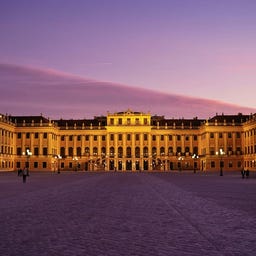
Once the magnificent summer residence of Maria Theresia, Emperor Franz Joseph, and his beloved Sissi, Schönbrunn Palace today captivates visitors from around the globe. With its sprawling gardens and rich imperial history, it has become Vienna's most popular attraction. The baroque masterpiece features over 1,400 rooms, of which around 45 are open for visitors, including:
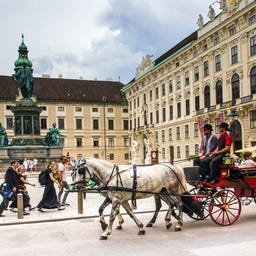
When you think of Vienna, Schönbrunn Palace and the historic center (the 1st District) immediately come to mind. Visit the Gothic St. Stephen’s Cathedral, steeped in legend, the imposing Hofburg, and the elegant shopping streets of Graben and Kärntner Straße. This is a neighborhood made for exploring – whether on a leisurely stroll, a romantic carriage ride, or over a cup of coffee in one of Vienna’s iconic coffeehouses.
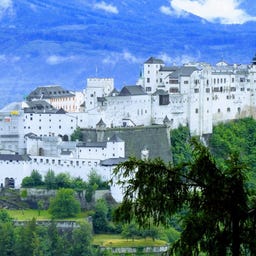
The Hohensalzburg Fortress towers majestically over Salzburg's Old Town and, with over 7,000 m² of built-up area, ranks among the largest fully preserved castle complexes in Europe. Since its construction began in 1077, it has been continuously expanded and today impresses with its late Gothic architecture as well as the magnificent princely chambers, which bring to life the world of the archbishops around 1500.
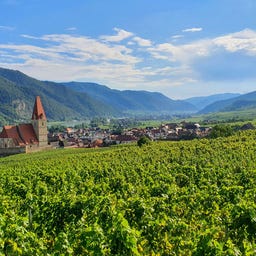
The Wachau is one of the most beautiful cultural landscapes in Austria and one of our favorite excursion destinations. This picturesque Danube valley stretches between the towns of Melk and Krems. It is not only famous for its terraced vineyards and the renowned Wachauer Marille (apricots) but also for Melk Abbeyand the castle ruins of Dürnstein (where King Richard the Lionheart was once held captive). Whether you're hiking on the World Heritage Trail, visiting during the apricot blossom season, or stopping by a traditional Heuriger, the Wachau offers unforgettable experiences for all your senses.
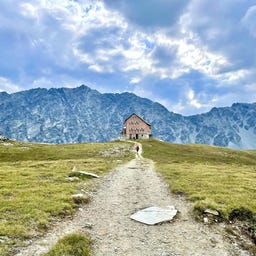
Nestled in the Alps and spanning Carinthia, Salzburg, and Tyrol, the Hohe Tauern National Park covers an area of 1,856 km², making it Austria’s largest national park and a mecca for nature lovers. The Großglockner, Austria’s highest mountain, rises above an immense region with over 300 peaks exceeding 3,000 meters, 342 glaciers, and roaring waterfalls such as the Krimml Waterfalls.
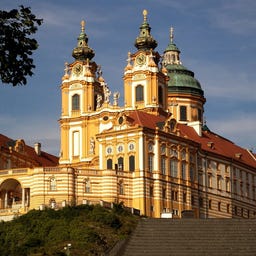
Nestled in the picturesque landscape of the Wachau, the magnificent Melk Abbey rises above the Danube. Built between 1702 and 1746 based on designs by Jakob Prandtauer, the abbey is considered a masterpiece of Baroque architecture and is recognized as a UNESCO World Heritage Site. In addition to regular concerts and changing exhibitions, the monastery offers fascinating insights into the spiritual life of the Benedictines.
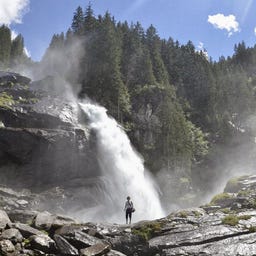
The Krimml Waterfalls, Austria’s highest waterfalls are a breathtaking natural spectacle in the heart of the Hohe Tauern National Park. With an impressive drop of 380 meters across three tiers, they attract thousands of visitors each year who come to experience the roaring water and the therapeutic effect of the fine mist.
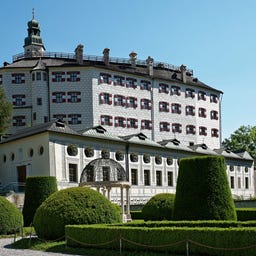
Once envisioned by Archduke Ferdinand II. as one of the world’s first museums, Ambras Castle dazzles with its elegant Renaissance architecture, the magnificent Spanish Hall, and a unique art and curiosity cabinet. Visitors can trace the legacy of the Habsburg Dynasty and unwind in the sprawling castle park—a hidden jewel in the Tyrolean Alps.
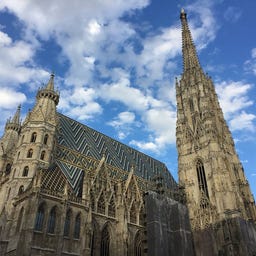
The Steffl, as the Viennese lovingly call St. Stephen’s Cathedral, is the famous landmark of Vienna. Its striking Gothic architecture, crowned by the 136 m tall South Tower, dominates the heart of Vienna. Legends surround its lengthy construction period, including one that claims the architect struck a deal with the devil to fund the project in exchange for his soul. Indeed, construction of the Gothic church spanned from 1304 to 1511, with the North Tower left unfinished due to the Turkish threat, allowing a shift in focus to defending the city.
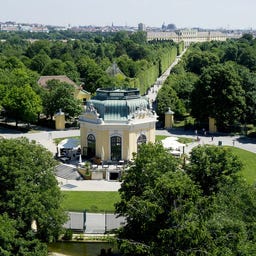
The Tiergarten Schönbrunn is not only the oldest operating zoo in the world (founded in 1752 by Emperor Francis I Stephen of Lorraine as an imperial menagerie), but has also been repeatedly voted the best zoo in all of Europe. This is thanks to the tremendous efforts of the zoo directors, who have gradually transformed the old cages into enclosures as close to nature as possible.
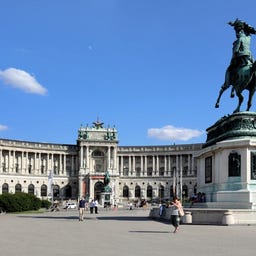
The Hofburg is a symbol of imperial splendor deeply rooted in the history of the Habsburg Monarchy. Originally built in the 13th century as a medieval fortress for the Habsburgs, the residence grew through continuous expansions into one of the largest palace complexes in Europe. This magnificent structure, developed over more than 700 years, combines Gothic, Baroque, and Neoclassical architecture and is a must-see highlight for all visitors to Vienna. Today, the Hofburg houses not only the offices of the Federal President but also renowned attractions such as:
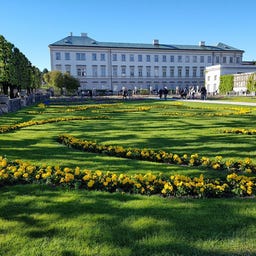
The baroque Mirabell Palace is one of Salzburg's most famous landmarks. Originally built in 1606 by Prince-Archbishop Wolf Dietrich von Raitenau for his mistress Salome Alt, it was later renamed "Mirabell" by Markus Sittikus, meaning "wonderfully beautiful." Particularly impressive are the magnificent Marble Hall, considered one of the world's most beautiful wedding halls today, and the intricately designed Angel Staircase with its delicate marble statues.

When you visit Salzburg, you simply must stroll through the city's Old Town. As the birthplace of Mozart and home to the renowned Salzburg Festival, this former princely city rightly belongs on the UNESCO World Heritage list. Start your walking tour from the Mirabell Gardens and cross the Salzach River via the Makartsteg bridge. Within the medieval city walls you’ll find a maze of narrow, crooked alleys lined with cute shops and luxurious jewelry stores. Follow Getreidegasse, the most popular shopping street,before arriving at the Cathedral Square. Here you can visit the magnificent Salzburg Cathedral. Most of the impressive architecture you’ll see is from the Baroque era, shaped by Italian masters such as Vincenzo Scamozzi and Santino Solari.
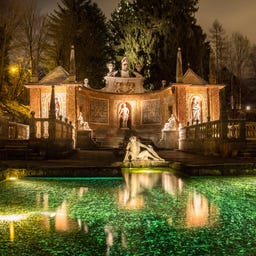
Located in the southern part of Salzburg, the Hellbrunn Palace is a Mannerist pleasure palace and a magnet for visitors from around the world. Built in the early 17th century by Prince-Archbishop Markus Sittikus von Hohenems, the estate delights both young and old with its playful water features, where hidden fountains provide wet surprises. Highlights include the mechanical theater, featuring around 200 water-powered figures, and the Stone Theater, the oldest open-air theater in Europe.
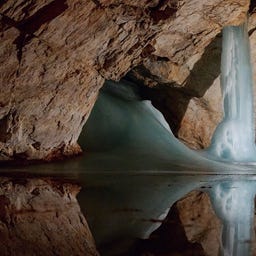
The Eisriesenwelt near Werfen is the largest ice cave in the world and a spectacular natural wonder that attracts thousands of visitors from all over the globe each year. The first 1,000 meters of the cave are open to tourists, showcasing gigantic ice formations, including the 25-meter-high Great Ice Wall. Located high in the Tennengebirge mountains at 1,656 meters above sea level, this adventure also offers breathtaking views over Salzburg’s countryside.
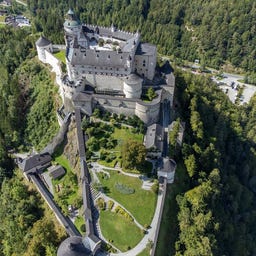
The Hohenwerfen Fortress rises majestically on a 155-meter-high rocky cone above the Salzach Valley and is one of Austria's most impressive medieval castles. Built in the 11th century, it once served as a military stronghold and hunting lodge for the Prince-Archbishops of Salzburg. Located in Werfen, about 40 km south of Salzburg, it is a particularly popular destination for families. The castle attracts visitors from around the globe with its exciting guided tours, daily bird of prey demonstrations, and the falconry museum featuring a bird of prey educational trail.
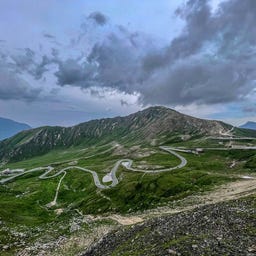
The Grossglockner High Alpine Road is one of Austria’s most famous and breathtaking panoramic routes. With its 36 hairpin bends and an altitude difference of over 1,500 meters, it winds through 47 km of stunning landscapes, from lush forests to rugged glaciers. Highlights like the Kaiser-Franz-Josefs-Höhe and Edelweißspitze offer unforgettable views of the mighty Grossglockner and the Pasterze Glacier.
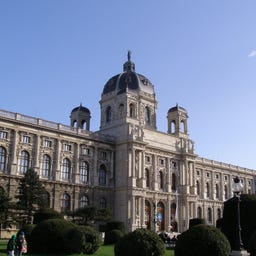
The Kunsthistorisches Museum (KHM) is one of the most significant and magnificent museums in the world, a must-visit for culture and art enthusiasts. Located at the Ring, between the Hofburg and the MuseumsQuartier, it impresses with its architectural splendor in the style of Italian Neo-Renaissance (built in 1891). The collections include masterpieces by Bruegel, Rubens, and Rembrandt as well as fascinating artifacts from antiquity and ancient Egypt. Particularly famous is the "Saliera" by Cellini, a treasure of the Kunstkammer Vienna. The museum's interior also captivates visitors with artworks by Gustav Klimt. A visit to the KHM should definitely be on your itinerary when traveling to Vienna.
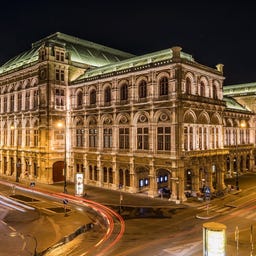
The Vienna State Opera, constructed in the Neo-Renaissance style, transports visitors to another era with its elegant façade and opulent interiors. Since its opening in 1869 with Mozart’s Don Giovanni, the opera house has made music history and captivates audiences with around 350 high-quality performances annually. The guided tours, which offer a glimpse behind the scenes of one of the world’s most famous opera houses, are especially popular with tourists.
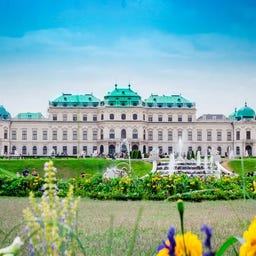
In the magnificent summer residence of the superstar Prince Eugene of Savoy, you’ll find one of Austria's most significant art museums. Here, you can explore Austrian art history from the Middle Ages to the 21st century. A particular focus lies on the Fin de Siècle and Art Nouveau periods, with the world's largest Gustav Klimt collection as its centerpiece.
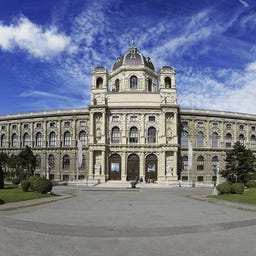
The Natural History Museum Vienna is one of the largest and most significant collections in the world, boasting around 30 million objects that vividly document the diversity of nature and the history of our planet. Located at the central Maria-Theresien-Platz opposite the Art History Museum, the building impresses with its magnificent historicist architecture and a distinctive dome crowned by a statue of the sun god Helios. Highlights include:
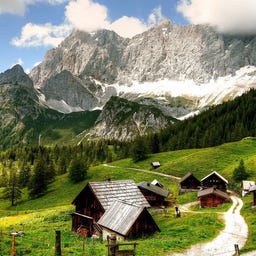
The Dachstein – a majestic mountain range in Austria's Northern Limestone Alps – features breathtaking glacier landscapes, impressive karst formations, and a wealth of activities for hikers, climbers, and winter sports enthusiasts. As the highest peak in both Styria and Upper Austria, the Hohe Dachstein (2,995 m) is not only a draw for mountaineers but also part of a UNESCO World Heritage Site.
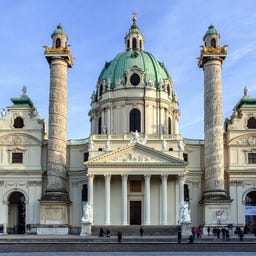
The Karlskirche, with its green dome and unique relief columns, is among the most significant sacred buildings in Central Europe. Commissioned by Emperor Charles VI in gratitude for the end of the 7th plague epidemic, the church was dedicated to St. Charles Borromeo, patron saint against epidemics. Designed by Johann Bernhard Fischer von Erlach, it was completed by his son and inaugurated in 1737 after 21 years of construction.
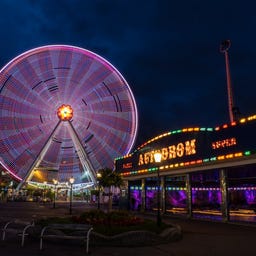
The Wurstelprater, known simply as the Prater, has been delighting visitors from around the world with its mix of nostalgia and thrills since the 18th century. Back in 1766, Emperor Joseph II opened the former imperial hunting grounds to the public, and since then, the Prater has become a popular destination for all. Today, the iconic Vienna Giant Ferris Wheel, built in 1897, serves as the park’s distinctive landmark, offering a stunning view of the city. (Just be patient, as the gondolas ascend at a leisurely pace.) With more than 200 attractions, from relaxed carousels and haunted houses to roller coasters and adrenaline-pumping rides like the 117-meter-high Prater Tower, the Prater is a favorite leisure spot for families, students, and adults alike.
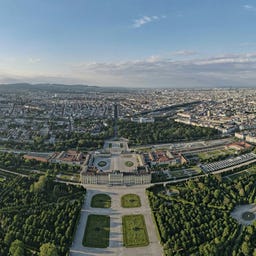
The palace park is a magnificent Baroque garden ensemble surrounding the former summer residence of the Habsburgs and part of the UNESCO World Heritage. It was designed in the French style in the early 18th century and later expanded under Maria Theresa. From the Gloriette with its splendid panoramic view of Vienna to the magnificent Neptune Fountain, the park is brimming with treasures. Artfully designed flower beds, sculptures, and fountains invite leisurely strolls, while the glass Palm House and the world’s oldest zoo captivate visitors of all ages. A walk through the small forest often reveals adorable squirrels.
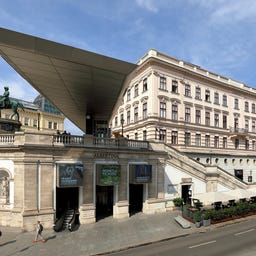
The Albertina, one of Europe's most important art museums, is an absolute highlight for culture enthusiasts. Founded in 1776, it now houses over one million graphics and drawings by greats such as Dürer, Michelangelo, and Picasso, as well as masterpieces of painting from Monet to Matisse. Especially Dürer’s Hare is world-famous. Located in the Palais Erzherzog Albrecht and complemented by the modern Soravia Wing, the Albertina showcases all the major artists of modern and contemporary art history.
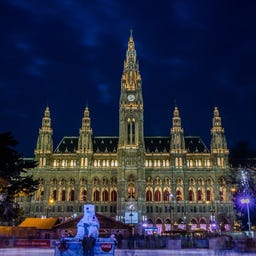
Along the Ringstraße, the Vienna City Hallsoars 103.3 meters into the sky. Constructed between 1872 and 1883 under the guidance of Friedrich von Schmidt, it’s inspired by the Gothic style of Flemish town halls yet incorporates Baroque elements with its seven arcaded courtyards. Following Emperor Franz Joseph’s command, the tower could not surpass the 99-meter-highVotive Church. However, the architect found a clever solution: he built the tower to 97.9 meters and crowned it with a statue, the Rathausmann!
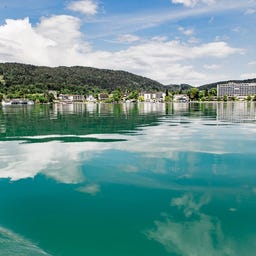
Lake Wörthersee, with an area of 19.39 km², is the largest lake in Carinthia and, thanks to its unique climate, one of the warmest alpine lakes overall—during summer, the water regularly exceeds 25°C.
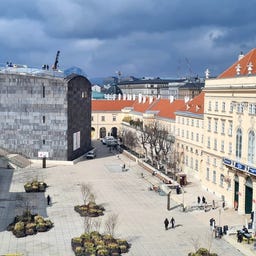
Between the historic baroque facades and modern buildings, you’ll find cozy cafés, lounge areas, and open courtyards that are particularly inviting in summer. Young people chat on the iconic MQ furniture, while a wealth of museums is right at your doorstep:
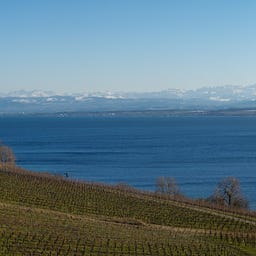
At the tripoint between Germany, Austria, and Switzerland lies Lake Constance - the largest and deepest lake in Germany, inhabited since the Stone Age. Here, you can expect a unique cultural landscape with UNESCO World Heritage sites like the Monastic Island of Reichenau, picturesque towns such as Constance and Lindau, and the flower-filled island of Mainau. The lake not only provides drinking water for 4.5 million people but also offers ideal conditions for viticulture and fruit orchards due to its mild climate. Whether sailing, cycling along the Lake Constance Cycle Path, or taking a cruise with the "White Fleet," the diverse recreational opportunities make Lake Constance one of the most popular holiday destinations in Central Europe.
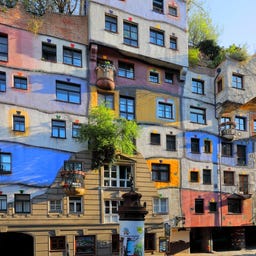
The Hundertwasser House in Vienna is a vibrant art piece that vividly showcases the vision of the extraordinary artist Friedensreich Hundertwasser. With its irregular shapes, bold colors, and lush greenery, it’s a striking architectural landmark. Built in the 1980s, this unique residential building embodies Hundertwasser’s dream of a harmonious connection between humans, architecture, and nature. Its balconies and rooftops host over 200 trees and shrubs, creating a green oasis in the heart of the city.
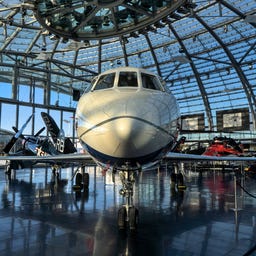
At the edge of Salzburg Airport stands the futuristic Hangar-7, an elliptical gem made of steel and specialty glass. The building houses not only a collection of historic airplanes, helicopters, and Formula 1 race cars belonging to the late entrepreneur Dietrich Mateschitz, who passed away in 2022, but also rotating exhibitions of contemporary art. The highlight is undoubtedly the collection of the Flying Bulls, which brings history to life with rarities like the Douglas DC-6B.
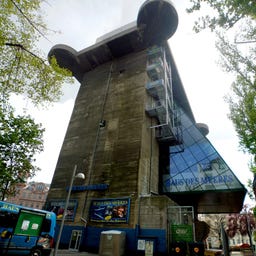
The Haus des Meeres is a unique Aqua Terra Zoo housed in a former flak tower from the Second World War. Over 11 floors, more than 10,000 animals from around 600 species, including sharks, rays, monkeys, and crocodiles, can be admired. A special highlight is the 360° shark tank on the 7th floor, offering views of these majestic sea creatures from every angle. On the top floor, the OCEAN SKY Restaurant entices visitors with its panoramic view of Vienna.
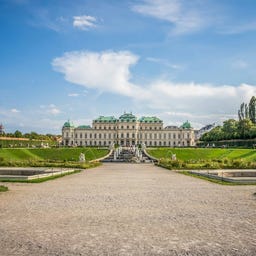
The Belvedere Garden in Vienna is a masterpiece of Baroque garden design and an enduring legacy of the Habsburg monarchy. Designed by Johann Lucas von Hildebrandt between 1714 and 1723 at the request of Prince Eugene of Savoy, the celebrated military commander, the expansive grounds captivate with their symmetrical layout and dramatic terracing, which elegantly emphasize the elevation differences between the Upper and Lower Belvedere. Today, the two buildings house the renowned Belvedere collections (incl. Klimt) and host temporary exhibitions.
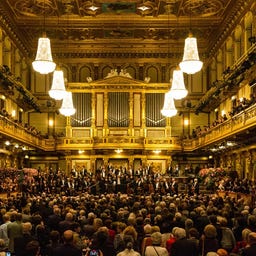
The Vienna Musikverein is not only one of the most prestigious concert halls in the world but also an architectural masterpiece. Built in 1870 by Theophil Hansenin the neoclassical style, the building resembles an ancient temple. Its most famous feature is the phenomenalGolden Hall, celebrated for its outstanding acoustics, which make it one of the best concert halls in the world. The acoustic perfection arises from a flawless combination of room proportions, wood paneling, and wall decorations, which create an unparalleled clarity and richness of sound.
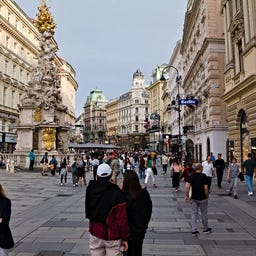
As a tourist, you simply can't miss the Graben, one of the city's most impressive promenades. Once a Roman defensive trench, you'll now find magnificent architecture, luxurious shops, and Viennese tradition here. Open your eyes and take a look around. Hardly anyone overlooks the baroquePlague Column, which commemorates the end of the plague epidemic in the 17th century, but pay special attention to the splendid buildings like the Grabenhof and the Ankerhaus.

Right next to the Ringstraße, you’ll step into the expansive, imperial Heldenplatz. Surrounded by the imposing Hofburg, the Outer Castle Gate, and two striking equestrian statues – Archduke Charles and Prince Eugene of Savoy – you can truly feel the grandeur of the Hofburg here. Today, the square often serves as a venue for events as well as political demonstrations.
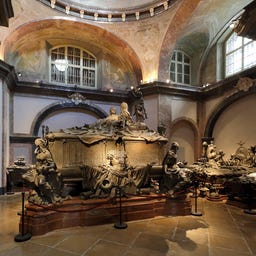
The Capuchin Crypt in Vienna, also known as the Imperial Crypt, is not only Austria's largest crypt in terms of area but also offers a deep dive into the history of the Habsburgs. Managed by the Capuchin Order since its establishment in the 17th century, it has served as the final resting place of this powerful dynasty for over 400 years. It houses the intricately designed sarcophagi of 12 emperors and 19 empresses, including Maria Theresa, Emperor Franz Joseph I., and the legendary Empress Elisabeth ("Sisi"). With over 150 members of the Habsburg family buried here, it is the second-largest crypt in the country, surpassed only by the Batthyány Family Crypt in Güssing.
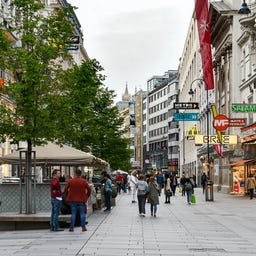
Already known in 1257 as an important trade route ("Strata Carintianorum") to Carinthia, the shopping street is now an elegant and popular pedestrian zone stretching from St. Stephen's Cathedral to the Vienna State Opera. Its magnificent architecture, ranging from historic palaces like Grundemann Esterházy to modern facades, reflects Vienna's transformation through the centuries.
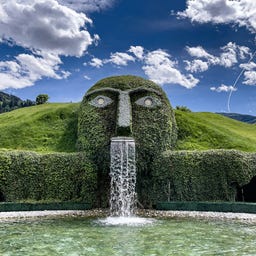
In the Swarovski Crystal Worlds in Wattens, Austria, near Innsbruck, you can expect a fascinating blend of art museum, park, and experience world. Opened in 1995, the facility was designed by André Heller as a giant head figure - the "Giant" - and houses 18 underground "chambers of wonders" featuring crystal interpretations by internationally renowned artists like Brian Eno and Salvador Dalí.
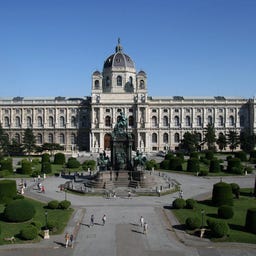
Between the two magnificent museums – the Art History Museum and the Natural History Museum – stretches Maria-Theresien-Platz. Whether you explore the collections of the outstanding museums, admire the extraordinary architecture on a leisurely stroll, or enjoy the festive atmosphere of the Christmas market in December, Maria-Theresien-Platz is one of Vienna’s highlights.
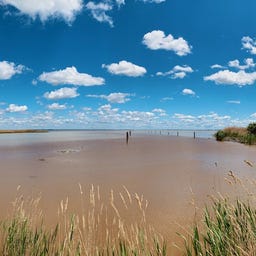
The Neusiedler See – shallow, vast, and full of character – lies between the gentle Burgenland and the expansive plains of Hungary. With its dense reed belt and mild Pannonian climate, the lake provides the perfect setting for sailors, cyclists, and nature lovers. In 2001, the cultural landscape of Fertő/Neusiedler See was added to the UNESCO World Heritage List.
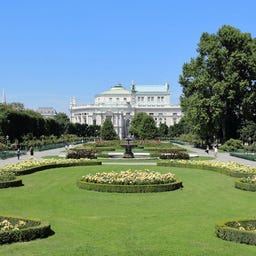
The magnificent Volksgarten is a wonderful place to take a breather amidst the many nearby attractions. Stroll among the 3,000 rose bushes featuring around 400 varieties of roses, and take a seat on one of the many benches. Here, you can truly relax in the sun surrounded by blooming flowerbeds. The park is also home to the elegant neoclassical Theseus Temple, a replica of the ancient Theseion in Athens, which today hosts events and exhibitions.
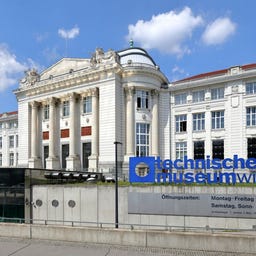
At the Technical Museum, the boundaries between past and future blur. Spanning over 22,000 m², you’ll discover interactive exhibitions, an impressive collection of large trains, vintage airplanes and vehicles, as well as exciting workshops for kids and teens, such as those featuring 3D printers.
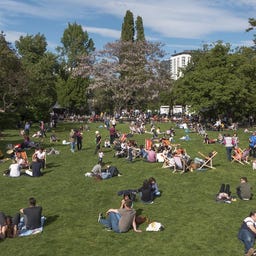
The Stadtpark, opened in 1862, is the oldest public park in Vienna and stretches like a green ribbon between the 1st and 3rd districts. It links the Ringstrasse to the U3/U4 station Landstrasse. Despite its popularity, the park remains a peaceful place for leisurely strolls, except during major events.
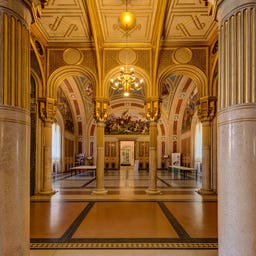
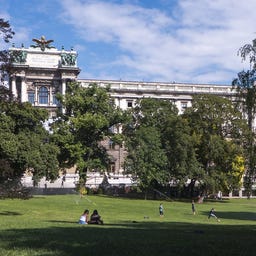
Directly behind the Neue Hofburg and the Albertina lies the idyllic Burggarten, a popular summer hangout for students. Originally designed in the 19th century as a private garden for Emperor Franz I, it now serves as a green oasis for locals and visitors alike. Impressive attractions such as the café in the Palmenhaus with its exotic plants, the charming Butterfly House, the statue of Wolfgang Amadeus Mozart, and a small pond with ducks invite you to linger.
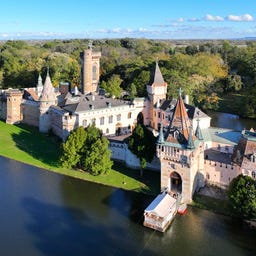
If you want to discover one of Austria’s most beautiful landscape parks, plan a half- or full-day trip to Laxenburg, just 15 km from Vienna. Once the summer retreat of the Habsburgs, this 280-hectare park invites you to unwind amidst monuments, charming paths, and the romantic castle pond.
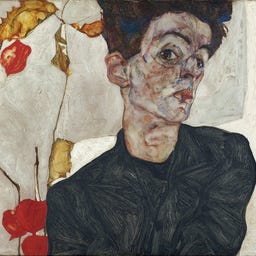
At the Leopold Museum, you can immerse yourself in the fascinating world of Viennese Modernism. The building, made of radiant white shell limestone, houses the world’s largest collection of works by the expressionist Egon Schiele, along with masterpieces by Gustav Klimt, Oskar Kokoschka, and other turn-of-the-century artists. On five floors, you’ll discover not only paintings but also handicrafts, furniture from the Wiener Werkstätte around 1900, as well as sculptures by Rodin and Lucian Freud.
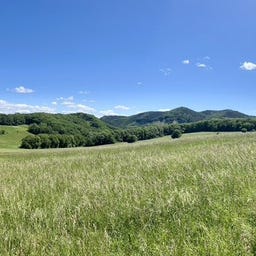
Between the dense deciduous forests of the Vienna Woods, you’ll find the perfect escape from Vienna’s hustle and bustle. Just a stone's throw from the capital, this forest (now a UNESCO biosphere reserve) is the beloved local retreat for Viennese residents. Whether you are climbing the highest peak, the Schöpfl at 893 meters, watching kite flying at Gießhübl, savoring a pleasant summer evening with a glass of Veltliner at a traditional Heuriger, or visiting the Heiligenkreuz Abbey – there are countless ways to relax here.
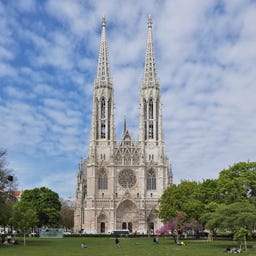
The neo-Gothic Votivkirche is one of Vienna’s most beautiful churches, surprising even locals with its remarkable history. Built between 1856 and 1879, it was created as an expression of gratitude for the survival of the young Emperor Franz Joseph I after an assassination attempt. In 1853, a Hungarian journeyman tailor attacked him with a kitchen knife, but the emperor’s life was saved by the courageous intervention of his adjutant. In response, his brother launched a donation campaign (Votivgabe), which was supported by 300,000 citizens. The church thus became a symbol of thanks for the emperor’s rescue.
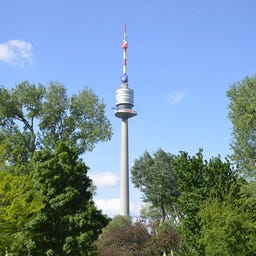
The Danube Tower, Austria's tallest attraction at 252 meters, rises as a gray column in the Donaupark of Vienna's 22nd district. Opened in 1964 for the Vienna Intern. Garden Show, the tower offers a unique experience: take the express elevator to the glassed-in observation deck at a height of 150 meters. From here, enjoy a breathtaking 360° view of Vienna and the Danube – from the city center to the vast landscapes of Lower Austria.
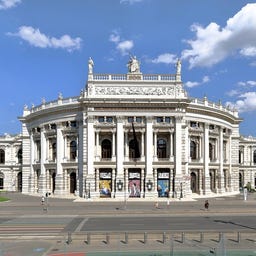
The Burgtheater, located directly on the magnificent Ringstraße opposite Rathausplatz, is a central venue for German-language stage art. Founded in 1741 by Maria Theresia and later relocated to its current site in 1888, the "Burg" captivates visitors with its opulent interiors and modern program.
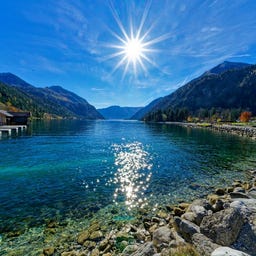
The Achensee, often referred to as the "Tyrolean Sea," is the largest lake in Tyrol, covering an area of 6.8 square kilometers, and impresses with its crystal-clear water that is suitable for drinking.
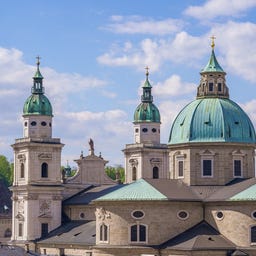
The Salzburg Cathedral is the first early Baroque church north of the Alps and one of Salzburg's most important landmarks. Built between 1614 and 1628 by architect Santino Solari, the cathedral impresses with its imposing façade made of Untersberg marble, two distinctive towers, and a massive dome. Originally consecrated in 774, it was repeatedly rebuilt after being destroyed by fires, with the current structure dating back to the 17th century. Highlights include:

High above the city, the mighty Kufstein Fortress welcomes you, with a history dating back to the early 13th century. The expansive complex, covering 24,000 m², is home to the Kufstein Local Museum, featuring Bronze and Stone Age artifacts, as well as the Heroes' Organ - the largest outdoor organ in the world, which plays daily at noon.
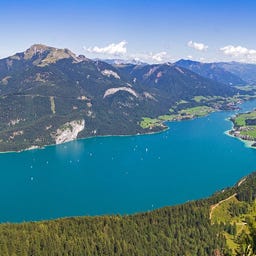
The Wolfgangsee is the largest lake in the state of Salzburg, covering over 13 square kilometers of water surface, and is divided by a unique, ever-changing border between Salzburg and Upper Austria. As part of the Salzkammergut, it attracts visitors with its crystal-clear water, reaching depths of up to 113 meters, and offers excellent conditions for swimming, sailing, and diving.
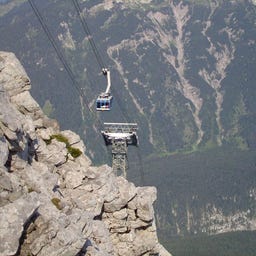
From the Austrian side, the Tiroler Zugspitzbahn takes you from Ehrwald-Obermoos to the summit of the Zugspitze in just 7.2 minutes. Opened in 1926, this cable car was the first to reach the Zugspitze and underwent a complete modernization in 1991 after a varied history.
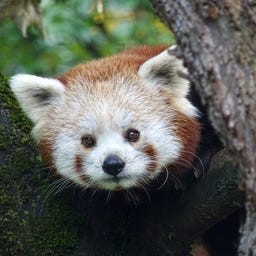
In the midst of the Hellbrunn Palace Park, the GeoZoo awaits you with around 1,500 animals from 150 species. The area, which has been used as a wildlife park since the 15th century, delights visitors with its natural design, where rock walls and the Salzburg mountain landscape are harmoniously integrated into the animal enclosures. A particular highlight is the spacious savanna enclosure with rhinos and zebras, while free-roaming lemurs regularly enchant visitors. With barrier-free paths, daily feedings, and events, the zoo is a highlight for visitors of all ages.
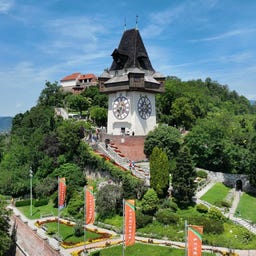
The Graz Schloßberg is the heart of Graz – a 123m high dolomite rock rising above the city center, captivating visitors with its 360° panoramic view. The history of the Schloßberg, once home to an impregnable fortress, dates back to the Middle Ages. Especially famous are the Clock Tower, with its reversed hands, and the Bell Tower, which houses the largest bell in Styria.
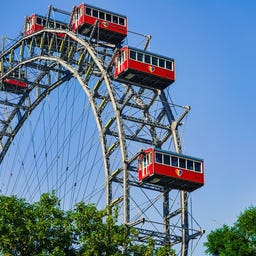
The Viennese Giant Ferris Wheel (Wr. Riesenrad) at the entrance to the Wurstelprater is one of Vienna’s most iconic landmarks. Built in 1897 to celebrate the 50th anniversary of Emperor Franz Joseph I’s reign, it was one of the largest Ferris wheels in the world at the time. Designed by British engineers Harry Hitchins and Hubert Cecil Booth and constructed by Walter Bassett, this technical marvel has become a symbol of the city. Today, with a height of 64.75 meters and its 15 distinctive red-and-white carriages, it offers breathtaking views of Vienna’s skyline and the Prater.(Be prepared for a leisurely pace, as the gondolas move slower compared to modern standards.) For a touch of romance, you can even book a special dinner experience in one of the carriages.
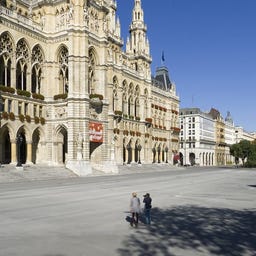
Rathausplatz, located along the Ringstraße opposite the Burgtheater, is a must-see during your visit to Vienna. Dominated by Vienna's City Hall, a masterpiece of neo-Gothic architecture from the late 19th century, the square impresses with its architectural beauty and vibrant events. From the famous Christkindlmarkt, with its enchanting lights and aromas, to the sparkling ice rink of the Vienna Ice Dream, and the Film Festival, which fills the summer with music and culinary delights, there’s always something happening here.
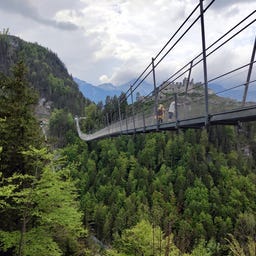
The Highline179 is one of the longest pedestrian suspension bridges in the world, connecting the historic sites of Ehrenberg Castle Ruins and Fort Claudia in Reutte, Tyrol. At a height of 114 meters, you cross 406 meters over the Fernpass road while enjoying the view of the impressive fortress structures.
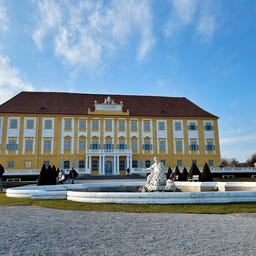
In the picturesque Marchfeld region, just an hour from Vienna, the baroque Schloss Hof invites visitors – and enchants with a petting zoo that makes children's eyes light up. While little ones get up close with rare animal breeds like Mangalitza pigs, donkeys, or Carinthian spectacled sheep, or conquer the adventure playground, adults can enjoy the expansive baroque gardens or the magnificent orangery. An ideal destination for a day trip.
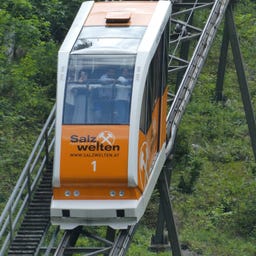
Some places are older than you can imagine. Perched high above Lake Hallstatt, the cool, dark tunnels of the world’s oldest salt mine transport you back more than 7,000 years. Here, prehistoric miners used rudimentary tools to extract the "white gold" that brought prosperity to Hallstatt during the early Iron Age. This fascinating excursion appeals to visitors of all ages. It’s no surprise that the salt mine is one of the most popular attractions in Upper Austria.
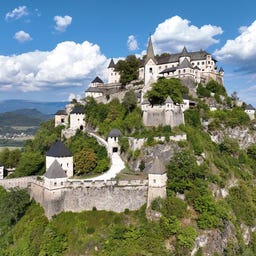
Majestically, Hochosterwitz Castle sits atop a 175-meter-high dolomite rock overlooking the Carinthian landscape. On your way to the main castle, you will pass through no less than 14 impressive gates, which were built between the 9th century and their major expansion under Georg von Khevenhüller in the 16th century.
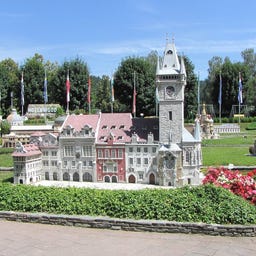
In Minimundus, a 26,000 m² miniature park in Klagenfurt, you can discover 165 detailed models of famous buildings, ships, and trains from around the world, all at a scale of 1:25.
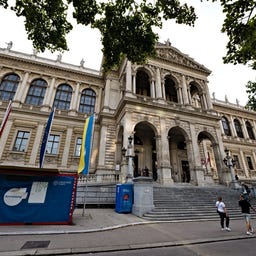
The University of Vienna, founded in 1365, is not only the largest university in the German-speaking world with 85,000 students but also the oldest. A visit to this stunning building is absolutely worthwhile. Located near the City Hall, the main building was designed by Heinrich von Ferstel in the style of the Italian Renaissance and opened in 1884. Climb the steps alongside hundreds of students and admire the richly decorated façade, the spacious staircases, and the artistic ceiling paintings.
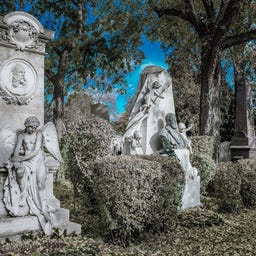
With its incredible size of 2.5 km², Vienna's Central Cemetery is larger than the city center and is home to over 3 million residents – more than the living population of Vienna. With its 1,000 honorary graves, Art Nouveau architecture, and sprawling grounds, the Central Cemetery is one of the most extraordinary sights in Vienna.
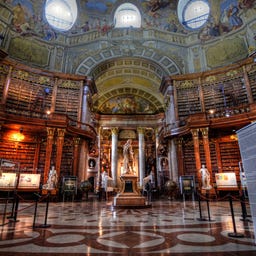
The National Library in the Neue Burg at Heldenplatz is not only Austria's largest library but also a breathtaking masterpiece of Baroque architecture. The most impressive highlight is the State Hall, a 77-meter-long room adorned with magnificent frescoes by court painter Daniel Gran, intricate woodwork, and marble statues. You’ll also notice the massive Baroque globes, each over 1 meter in diameter.
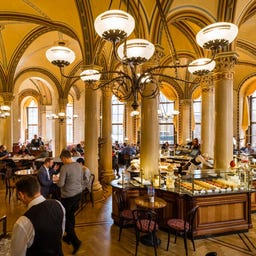
The Café Central is, despite its long queues, one of Vienna’s most popular attractions. With its marble columns, high vaulted ceilings, and Venetian flair, the Palais Ferstel exudes the elegance of Viennese coffeehouse culture.
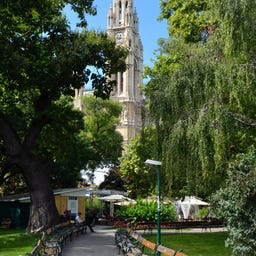
In the heart of Vienna, you’ll find the 40,000 square meter Rathauspark, which was created in 1873 under Mayor Cajetan Felder on the site of a former military parade ground. With its symmetrically arranged areas around two fountains and winding paths, the park today serves as a popular oasis of tranquility, also hosting urban events like the Eistraum and Adventzauber.
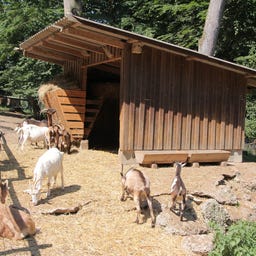
The Stadt Haag Zoo is a wonderful destination for animal lovers and families looking for a relaxing day in nature. Nestled in the Salaberg Castle Park, designed as an English landscape garden in the 19th century, you'll find over 700 animals from around 70 species, including big cats like North Chinese leopards, Siberian tigers, and lynxes, as well as squirrels, donkeys, Barbary macaques, zebras, and brown bears.
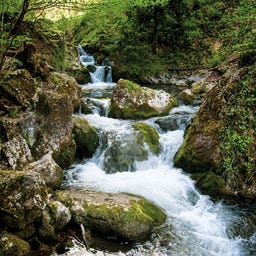
A short hiking trip to the Myra Falls in Muggendorf is a wonderful experience for the whole family. The well-maintained trail, featuring 11 themed stations, follows the course of the Myra stream across 26 bridges. Along its 125-meter descent, the stream forms a series of charming, small waterfalls, creating picturesque views at every turn.
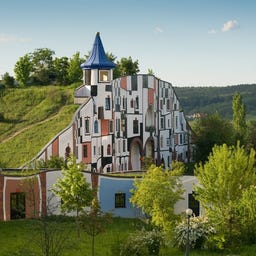
Bad Blumau is truly one of a kind. Designed by the extraordinary artist Friedensreich Hundertwasser, this vibrant, organic masterpiece is a joy to explore, whether for a day or two. The complex boasts forested rooftops, charming terrace gardens, golden domes, around 330 colorful columns, and over 2,400 windows—each one completely unique.
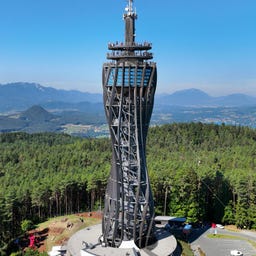
The tallest wooden observation tower in the world, standing at 100 meters, is located on Pyramidenkogel in Carinthia and offers you a breathtaking panoramic view of Lake Wörthersee and the surrounding region. The structure, made of wood and steel, was opened in 2013 and designed by architects Markus Klaura and Dietmar Kaden. Its twisted elliptical shape and natural ventilation are truly impressive. In addition to the glass Skybox restaurant, the tower attracts adrenaline enthusiasts with Europe’s highest building slide, a zipline, and a free-fall attraction. You can reach the various observation platforms by elevator or by climbing 441 steps, which draw hundreds of thousands of visitors each year since its opening.

In the Hallein Salt Mine south of Salzburg, you can experience firsthand how the "white gold" has been mined since the 7th century BC on guided 75-minute tours. The former mine, which operated until 1989, takes you through eight different mining levels and surprises you with a boat ride across an underground salt lake.
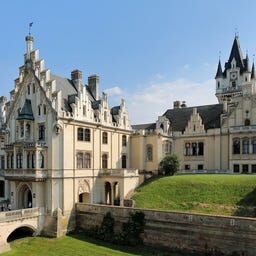
Some places feel like they belong to another era - Grafenegg Castle is one of them. With its fusion of Gothic, Baroque, and Renaissance architecture, set amidst an enchanting English landscape park, it’s like stepping straight into a storybook.
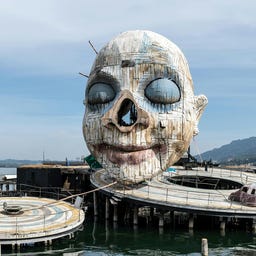
At the picturesque backdrop of Lake Constance, the Bregenz Festival awaits you, one of the most spectacular cultural festivals in Europe. Since 1946, the festival has been staging elaborate outdoor opera productions every summer on the world's largest lake stage, the Seebühne, with the Vienna Symphony Orchestra providing a unique sound experience. The festival attracts around 269,000 visitors with about 80 events between July and August, achieving an impressive occupancy rate of 98%. In case of bad weather, performances take place in the Festspielhaus Bregenz, which opened in 1980 and also hosts additional opera productions and orchestral concerts.
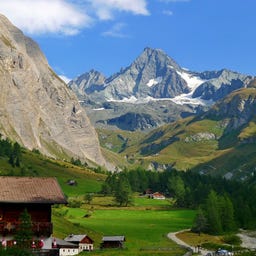
At 3,798 meters, the Großglockner is the highest mountain in Austria, impressing with its distinctive pyramid shape and glaciated appearance.
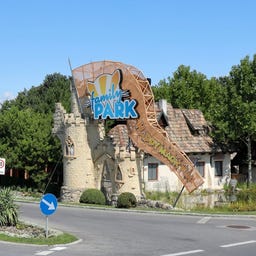
In Austria's largest amusement park, you can expect a total of 31 attractions spread over 145,000 m², divided into four themed areas: Adventure Castle, Fairy Tale Forest, Adventure Island, and Farm. What started in 1968 as a small fairy tale forest has developed over the decades into a versatile family park, which has been part of the French Compagnie des Alpes since 2019. Here, you'll find everything from cozy carousels to the Beaver Castle - Austria's largest white-water ride with a 17-meter drop. While the mascot Filippo welcomes the little visitors, the park also features a petting zoo with goats, ponies, and donkeys.

The Anker Clock at Hoher Markt is an intriguing Art Nouveau masterpiece. Since its completion in 1914, twelve historical figures – including Emperor Charles V, Prince Eugene of Savoy, Emperor Marcus Aurelius, Maria Theresa, and composer Joseph Haydn – pass one by one across the clock’s bridge every hour. (The bridge connects the buildings of the Anker Hof.)

Right below the impressive Landskron Castle, you'll find Austria's largest open-air enclosure for Japanese macaques, where around 180 of these fascinating monkeys live in a 40,000 square meter forest area. Since its establishment in 1996, the monkey mountain has become a popular destination, attracting 120,000 visitors each year.
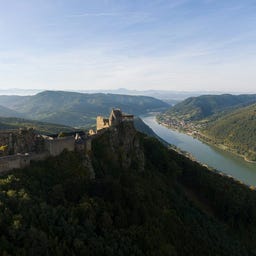
Perched high atop a steep 320-meter rocky spur, the Aggstein Castle Ruins are a place whose turbulent history is sure to send shivers down your spine. With views of the Danube and surrounded by the picturesque Wachau landscape, the ruins invite you to delve into the dark tales of the Middle Ages - from the robber baron Jörg Scheck vom Wald to the chilling "Rosengärtlein," where prisoners faced a cruel choice. Explore the ancient walls, join fascinating guided tours, and enjoy special events like the Castle Advent - all while taking in one of the region's most breathtaking panoramic views. A true highlight for anymedieval history enthusiast!
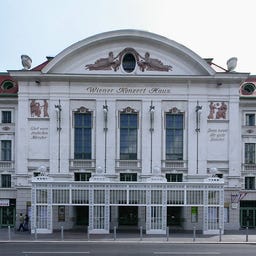
With its sumptuous blend of Art Nouveau and Historicism and acoustics that render even the subtlest sounds crystal clear, the Vienna Konzerthaus is a Mecca for music lovers. Since its opening in 1913, this gem has welcomed countless world-class artists such as Leonard Bernstein and Herbert von Karajan and remains one of Vienna's most treasured cultural landmarks.
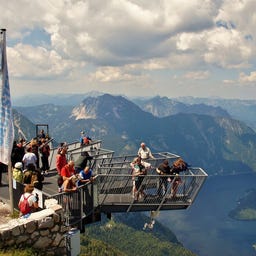
The 5fingers viewing platform on the Krippenstein is one of the nicest vantage points in the Alps. Like the five fingers of a hand, the platforms extend 400 meters above a sheer drop, offering stunning panoramic views of Hallstättersee, the UNESCO World Heritage region of Hallstatt-Dachstein, and the surrounding Salzkammergut.
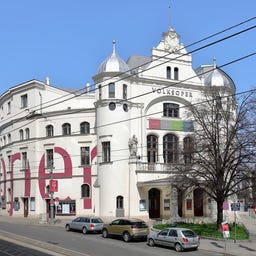
The Volksoper is a wonderful venue for anyone who enjoys classical performances but finds traditional opera too heavy. It's simply delightful to watch cheerful operetta classics like Die Fledermaus or The Merry Widow with their charming stage designs. Additionally, the program features captivating musicals and ballet, offering plenty of variety.
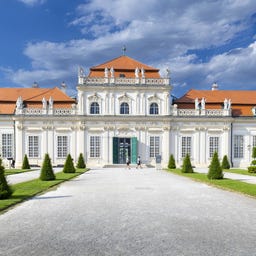
The baroque Lower Belvedere served as the summer residence of the legendary military commander Prince Eugene of Savoy. Built between 1712 and 1716 by Johann Lucas von Hildebrandt, the palace impresses with its elegant architecture. Today, it is a center for rotating art exhibitions, ranging from medieval treasures to contemporary works. Visitors can also explore the harmoniously designed gardens, which create a visual connection between the Lower and Upper Belvedere.
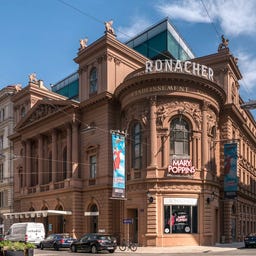
In the heart of Vienna's 1st district, you'll find the magnificent Ronacher, a true mecca for musical lovers. With around 1,000 seats, the historic yet elegant theater offers an intimate but spacious atmosphere, perfect for top-notch productions – from CatstoFalco – The Musical. Even John Malkovich graced this venue, performing as Casanova during the 2011 world premiere of The Giacomo Variations.
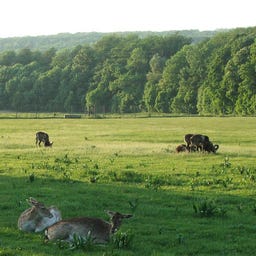
The former imperial hunting ground is now an idyllic nature reserve and a popular excursion destination in the southwest of Vienna. Established by Emperor Ferdinand I. in the 16th century, the wildlife park has been open to the public since 1919 and is home to numerous wild boars, red deer, and rare birds.
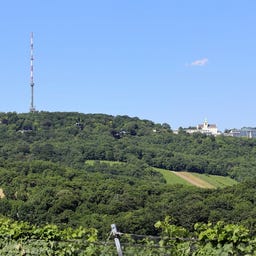
The Kahlenberg is a popular destination in the Vienna Woods, offering a breathtaking panoramic view of Vienna and the Danube. This spot has been historically significant for centuries: In 1683, Polish King Jan III Sobieski led the relief army to liberate Vienna during the Turkish siege from this very location.
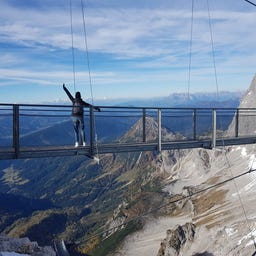
At an altitude of 2,700 meters, a truly unique experience awaits: The Stairway to Nothingness offers brave visitors the chance to step onto a glass platform suspended 400 meters above the ground and feel the breath of the Alps. Connected to the Dachstein Suspension Bridge, this attraction is one of the region's most spectacular highlights.
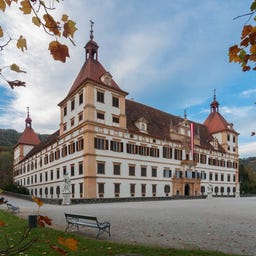
On Graz’s western edge stands Eggenberg Palace—the most important Baroque palace in Styria and part of the city’s UNESCO World Heritage Site. Built between 1625 and 1646, it’s a tribute to cosmic order, featuring:
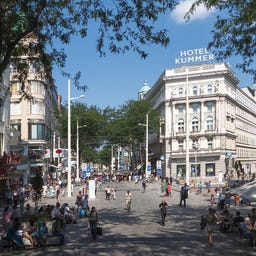
The Mariahilfer Straße is not only the longest shopping street in the city but also a vibrant hub full of life. Stretching over 1.8 km from Westbahnhof to the MuseumsQuartier, this paradise for shopping enthusiasts offers everything from international brands and a few resilient boutiques to the much-loved Bartolotti ice cream parlor, as well as some cafés and restaurants.

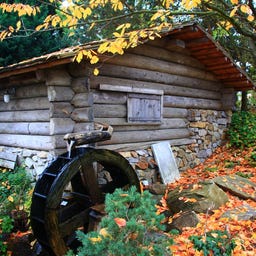
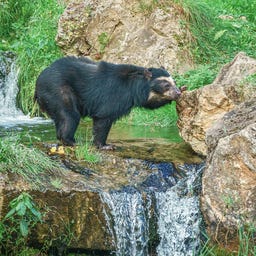
Do you feel like an adventure? This zoo takes you on a journey around the world, right in the heart of beautiful Eastern Styria. From lions and agile cheetahs to cheeky prairie dogs, over 80 animal species are waiting to be discovered by you. One of the highlights is Europe’s largest cheetah enclosure, where you can feel the wilderness up close! For little explorers, there’s also a lovingly designed petting zoo and playgrounds.
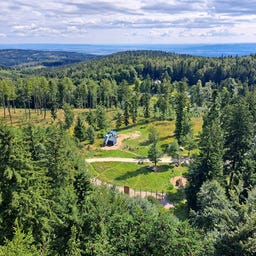
In the Hohe Wand Nature Park, you can expect an impressive rock formation of the Gutenstein Alps, with cliffs that drop steeply to the southeast, reaching heights of up to 230 meters. The expansive park combines alpine and Pannonian vegetation and offers not only marked hiking trails but also secured climbing routes, caves, and a spectacular Skywalk right at the edge of the cliffs.
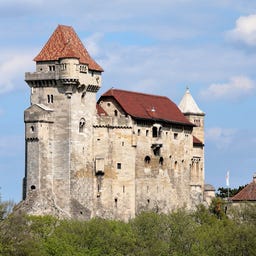
High above Maria Enzersdorf, the impressive Liechtenstein Castle stands on a narrow ridge, built in the 12th century by Hugo I. of Liechtenstein as part of a defensive line against attacks from the east. After being destroyed during the Second Turkish Siege of Vienna in 1683, it remained in ruins for a long time until the Princes of Liechtenstein repurchased it in 1808 and had it rebuilt in a neo-Romanesque style.
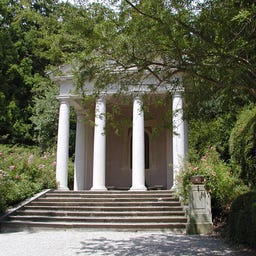
In the picturesque Kurpark located on Badener Berg, you will find a historically developed park that dates back to the 2nd century, when a Roman bathing district was established here. From the modest garden in front of the Theresienbad built in 1758, a vast park landscape with winding paths and impressive structures has evolved over the centuries.
